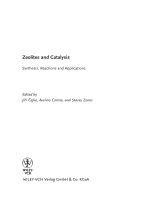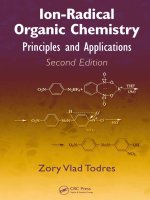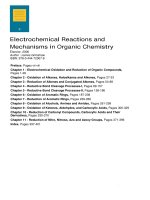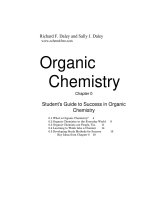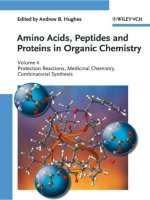Bernd plietker iron catalysis in organic chemistry reactions and applications wiley VCH (2008)
Bạn đang xem bản rút gọn của tài liệu. Xem và tải ngay bản đầy đủ của tài liệu tại đây (3.11 MB, 297 trang )
Iron Catalysis in Organic Chemistry
Edited by
Bernd Plietker
www.pdfgrip.com
Related Titles
Cornils, B., Herrmann, W. A., Muhler, M., Wong, C.-H. (eds.)
Catalysis from A to Z
A Concise Encyclopedia
2007
ISBN: 978-3-527-31438-6
Tietze, L. F., Brasche, G., Gericke, K. M.
Domino Reactions in Organic Synthesis
2006
SBN: 978-3-527-29060-4
Yudin, A. K. (ed.)
Aziridines and Epoxides in Organic Synthesis
2006
ISBN: 978-3-527-31213-9
Cornils, B., Herrmann, W. A., Horvath, I. T., Leitner, W., Mecking, S.,
Olivier-Bourbigou, H., Vogt, D. (eds.)
Multiphase Homogeneous Catalysis
2005
ISBN: 978-3-527-30721-0
Christoffers, J., Baro, A. (eds.)
Quaternary Stereocenters
Challenges and Solutions for Organic Synthesis
2005
ISBN: 978-3-527-31107-1
Dyker, G. (ed.)
Handbook of C-H Transformations
Applications in Organic Synthesis
2005
ISBN: 978-3-527-31074-6
Knochel, P. (ed.)
Handbook of Functionalized Organometallics
Applications in Synthesis
2005
ISBN: 978-3-527-31131-6
www.pdfgrip.com
Iron Catalysis in Organic Chemistry
Reactions and Applications
Edited by
Bernd Plietker
www.pdfgrip.com
The Editor
Prof. Dr. Bernd Plietker
Institut für Organische Chemie
Universität Stuttgart
Pfaffenwaldring 55
70569 Stuttgart
Germany
All books published by Wiley-VCH are carefully
produced. Nevertheless, authors, editors, and
publisher do not warrant the information contained
in these books, including this book, to be free of
errors. Readers are advised to keep in mind that
statements, data, illustrations, procedural details or
other items may inadvertently be inaccurate.
Library of Congress Card No.: applied for
British Library Cataloguing-in-Publication Data
A catalogue record for this book is available from the
British Library.
Bibliographic information published by
the Deutsche Nationalbibliothek
Die Deutsche Nationalbibliothek lists this
publication in the Deutsche Nationalbibliografie;
detailed bibliographic data are available in the
Internet at .
# 2008 WILEY-VCH Verlag GmbH & Co. KGaA,
Weinheim
All rights reserved (including those of translation into
other languages). No part of this book may be
reproduced in any form – by photoprinting,
microfilm, or any other means – nor transmitted or
translated into a machine language without written
permission from the publishers. Registered names,
trademarks, etc. used in this book, even when not
specifically marked as such, are not to be considered
unprotected by law.
Typesetting Thomson Digital, Noida, India
Printing Strauss GmbH, Mörlenbach
Binding Litges & Dopf GmbH, Heppenheim
Cover Design Adam-Design, Weinheim
Printed in the Federal Republic of Germany
Printed on acid-free paper
ISBN: 978-3-527-31927-5
www.pdfgrip.com
V
Contents
Preface XI
List of Contributors
1
1.1
1.2
1.2.1
1.2.2
1.3
1.3.1
1.3.2
1.3.3
1.3.4
1.3.5
1.3.6
1.3.7
1.4
1.4.1
1.4.2
1.4.3
2
2.1
2.1.1
2.1.2
2.1.2.1
XIII
Iron Complexes in Organic Chemistry 1
Ingmar Bauer and Hans-Joachim Knölker
Introduction 1
General Aspects of Iron Complex Chemistry 2
Electronic Configuration, Oxidation States, Structures 2
Fundamental Reactions 2
Organoiron Complexes and Their Applications 4
Binary Carbonyl–Iron Complexes 5
Alkene–Iron Complexes 7
Allyl– and Trimethylenemethane–Iron Complexes 8
Acyl– and Carbene–Iron Complexes 9
Diene–Iron Complexes 11
Ferrocenes 18
Arene–Iron Complexes 18
Catalysis Using Iron Complexes 20
Iron Complexes as Substrates and/or Products in Catalytic
Reactions 20
Iron Complexes as Ligands for Other Transition Metal Catalysts
Iron Complexes as Catalytically Active Species 21
References 24
Iron Catalysis in Biological and Biomimetic Reactions 29
Non-heme Iron Catalysts in Biological and Biomimetic
Transformations 29
Jens Müller
Introduction: Iron in Biological Processes 29
Non-heme Iron Proteins 30
Mononuclear Iron Sites 30
Iron Catalysis in Organic Chemistry. Edited by Bernd Plietker
Copyright Ó 2008 WILEY-VCH Verlag GmbH & Co. KGaA, Weinheim
ISBN: 978-3-527-31927-5
www.pdfgrip.com
21
VI
Contents
39
2.1.2.2
2.1.3
Dinuclear Iron Sites
Summary 45
References 46
2.2
Organic Reactions Catalyzed by Heme Proteins 48
Martin Bröring
Classification and General Reactivity Schemes of Heme Proteins
Used in Organic Synthesis 48
Organic Reactions Catalyzed by Cytochromes P450 51
Organic Reactions Catalyzed by Heme Peroxidases 56
Dehydrogenations (‘‘Peroxidase Reactivity’’) 56
Sulfoxidations (‘‘Peroxygenase Reactivity’’) 57
Peroxide Disproportionation (‘‘Catalase Reactivity’’) 58
Halogenation (‘‘Haloperoxidase Reactivity’’) 61
Epoxidations (‘‘Monoxygenase Activity’’) 62
References 66
2.2.1
2.2.2
2.2.3
2.2.3.1
2.2.3.2
2.2.3.3
2.2.3.4
2.2.3.5
3
3.1
3.1.1
3.1.2
3.1.3
3.1.4
3.1.5
3.2
3.2.1
3.2.2
3.2.2.1
3.2.2.2
3.2.2.3
3.2.2.4
3.2.2.5
3.2.3
3.2.4
3.3
3.3.1
Iron-catalyzed Oxidation Reactions 73
Oxidations of C–H and C¼C Bonds 73
Agathe Christine Mayer and Carsten Bolm
Gif Chemistry 73
Alkene Epoxidation 80
Alkene Dihydroxylation 82
The Kharasch Reaction and Related Reactions
Aziridination and Diamination 87
References 89
84
Oxidative Allylic Oxygenation and Amination 92
Sabine Laschat, Volker Rabe, and Angelika Baro
Introduction 92
Iron-catalyzed Allylic Oxidations 93
Simple Iron Salts 93
Fe(III) Complexes with Bidentate Ligands 94
Fe3ỵ/Fe2ỵ Porphyrin and Phthalocyanine Complexes 95
Iron(III) Salen Complexes 100
Non-heme Iron Complexes with Tetra- and Pentadentate
Ligands 100
Oxidative Allylic Aminations 103
Conclusion 107
References 107
Oxidation of Heteroatoms (N and S) 109
Olga García Mancho and Carsten Bolm
Oxidation of Nitrogen Compounds 109
www.pdfgrip.com
Contents
109
3.3.1.1
3.3.1.2
3.3.1.3
3.3.2
3.3.2.1
3.3.2.2
3.3.2.3
Oxidation of Hydroxylamines to Nitroso Compounds
Oxidation of Arylamines 110
Other N-Oxidations 110
Oxidation of Sulfur Compounds 111
Oxidation of Thiols to Disulfides 111
Oxidation of Sulfides 113
Oxidative Imination of Sulfur Compounds 119
References 122
4
Reduction of Unsaturated Compounds with Homogeneous
Iron Catalysts 125
Stephan Enthaler, Kathrin Junge, and Matthias Beller
Introduction 125
Hydrogenation of Carbonyl Compounds 125
Hydrogenation of Carbon–Carbon Double Bonds 129
Hydrogenation of Imines and Similar Compounds 136
Catalytic Hydrosilylations 136
Conclusion 141
References 142
4.1
4.2
4.3
4.4
4.5
4.6
5
5.1
5.2
5.3
5.4
5.5
5.6
5.7
6
6.1
6.2
6.2.1
6.2.2
6.2.3
6.2.4
6.2.5
6.2.5.1
6.2.5.2
6.3
Iron-catalyzed Cross-coupling Reactions 147
Andreas Leitner
Introduction 147
Cross-coupling Reactions of Alkenyl Electrophiles 147
Cross-coupling Reactions of Aryl Electrophiles 154
Cross-coupling Reactions of Alkyl Electrophiles 161
Cross-coupling Reactions of Acyl Electrophiles 168
Iron-catalyzed Carbometallation Reactions 170
Conclusion 172
References 173
Iron-catalyzed Aromatic Substitutions 177
Jette Kischel, Kristin Mertins, Irina Jovel, Alexander Zapf, and Matthias Beller
General Aspects 177
Electrophilic Aromatic Substitutions 178
Halogenation Reactions 178
Nitration Reactions 179
Sulfonylation Reactions 180
Friedel–Crafts Acylations 181
Friedel–Crafts Alkylations 183
Alkylation with Alcohols, Ethers and Esters 184
Alkylation with Alkenes 186
Nucleophilic Aromatic Substitutions 188
References 191
www.pdfgrip.com
VII
VIII
Contents
7
7.1
7.2
7.2.1
7.2.1.1
7.2.1.2
7.2.1.3
7.2.2
7.2.2.1
7.2.2.2
7.3
8
8.1
8.2
8.2.1
8.2.2
8.3
8.4
8.4.1
8.4.2
8.5
8.5.1
8.5.1.1
8.5.1.2
8.5.1.3
8.5.1.4
8.5.2
8.6
8.6.1
8.6.2
8.6.3
9
9.1
9.2
9.3
Iron-catalyzed Substitution Reactions 197
Bernd Plietker
Introduction 197
Iron-catalyzed Nucleophilic Substitutions 197
Nucleophilic Substitutions of Non-activated C–X Bonds 197
Introduction 197
Nucleophilic Substitutions Using Lewis Acidic Fe Catalysts 198
Substitutions Catalyzed by Ferrate Complexes 199
Nucleophilic Substitution of Allylic and Propargylic C–X Bonds 202
Reactions Catalyzed by Lewis Acidic Fe Salts 202
Nucleophilic Substitutions Involving Ferrates 205
Conclusion 213
References 214
Addition and Conjugate Addition Reactions to Carbonyl
Compounds 217
Jens Christoffers, Herbert Frey, and Anna Rosiak
Introduction 217
Additions to Aldehydes and Ketones 218
Oxygen Nucleophiles 218
Carbon Nucleophiles 219
Additions to Imines and Iminium Ions 223
Additions to Carboxylic Acids and Their Derivatives 224
Oxygen Nucleophiles 224
Carbon Nucleophiles 225
Conjugate Addition to a,b-Unsaturated Carbonyl
Compounds 226
Carbon Nucleophiles 226
Michael Reactions 226
Vinylogous Michael Reactions 230
Asymmetric Michael Reactions 232
Michael Reactions in Ionic Liquids and Heterogeneous
Catalysis 233
Nitrogen Nucleophiles 235
Synthesis of Heterocycles 236
Pyridine and Quinoline Derivatives 236
Pyrimidine and Pyrazine Derivatives 238
Benzo- and Dibenzopyrans 238
References 239
Iron-catalyzed Cycloadditions and Ring Expansion Reactions
Gerhard Hilt and Judith Janikowski
Introduction 245
Cycloisomerization and Alder–Ene Reaction 245
[2ỵ1]-Cycloadditions 249
www.pdfgrip.com
245
Contents
9.3.1
9.3.2
9.3.3
9.4
9.5
9.6
9.6.1
9.6.2
9.6.3
9.7
9.8
9.9
9.10
9.11
Iron-catalyzed Aziridine Formation 249
Iron-catalyzed Epoxide Formation 251
Iron-catalyzed Cyclopropane Formation 252
[2ỵ2]-Cycloaddition 254
[4ỵ1]-Cycloadditions 256
[4ỵ2]-Cycloadditions 257
DielsAlder Reactions with Normal Electron Demand 257
DielsAlder Reactions with Neutral Electron Demand 259
Diels–Alder Reactions with Inverse Electron Demand 260
Cyclotrimerization 260
[3ỵ2]-Cycloadditions 262
[3ỵ3]-Cycloadditions 263
Ring Expansion Reactions 263
Conclusion 266
References 266
Index
271
www.pdfgrip.com
IX
www.pdfgrip.com
XI
Preface
Sustainability has emerged as one of the keywords in discussions in the fields of
politics, society and science within the past 20 years. The need for the production of
high-quality products with minimum waste and energy demands is a key challenge
in todays environment. This is even more salient when the increase in the world
population and the decrease in fossil fuel resources are considered. In the field of
chemistry, the concept of sustainability is clearly defined by the use of low-waste
chemical transformations plus the use of catalysts in order to decrease the amount of
energy needed for a process. Although most catalytic reactions fulfill the criteria for a
sustainable transformation on the macroscopic scale, often the high price of catalysts, which are mostly transition metal based and their ligands paired with an
inherent toxicity contradict these criteria on a microscopic scale.
This contradiction has spurred interest in developing transformations that make
use of sustainable catalysis. Organocatalysis and biocatalysis both fulfill the criteria of
sustainable catalysis: The catalysts are cheap, readily accessible and non-toxic. In the
field of sustainable metal catalysis, iron-catalyzed transformations have evolved as
powerful tools for performing organic synthesis. This development is somewhat
surprising if one considers that the earliest iron catalysis dates back to the 1960s, a
point in time where late transition metal catalysis using palladium, ruthenium or
rhodium was still in its infancy. For some reason, which to me is one of the mysteries
in metal catalysis, iron complexes never attracted the same interest in catalysis as
their higher homologues in Group VIII metals, e.g. Ru, Os, Rh, Ir, Pd and Pt. This
development is even more astonishing if one considers the rich organometallic
chemistry of iron. It would appear that the current discussion about sustainability
(energy resources, non-toxic reagents, catalysts and green solvents, etc.) has led to
resurrection of iron catalysis in organic synthesis as a way to generate sustainable metal
catalysis.
Due this recent revival, there is the need for an authoritative review of this
important chemistry. It is the purpose of this book not only to introduce the
chemistry community to the most recent achievements in the field of catalysis,
but also to create a deeper understanding of the underlying fundamentals in the
organometallic chemistry of iron complexes.
Iron Catalysis in Organic Chemistry. Edited by Bernd Plietker
Copyright Ó 2008 WILEY-VCH Verlag GmbH & Co. KGaA, Weinheim
ISBN: 978-3-527-31927-5
www.pdfgrip.com
XII
Preface
Consequently, the first chapter of this multi-authored book introduces the reader
to the most general aspects of organoiron chemistry. The stability of complexes,
together with prominent examples of stoichiometric iron-mediated organic transformations, are presented in a concise way, providing a first insight into and
references to the leading review articles.
Iron complexes also play a dominant role in biological systems. The second
chapter focuses on aspects connected with heme and non-heme iron catalysts in
biological and biomimetic transformations. Most biological and biomimetic catalysts are employed in oxidation chemistry. Hence the reader can compare these
systems with artificial catalytic oxidations, e.g. Gif chemistry and allylic and heteroatom oxidations, which are summarized in Chapter 3. Catalytic reductions in the
presence of iron complexes are the synthetic counterpart to the oxidations and are
reviewed in Chapter 4. Chapters 5–7 deal with different aspects of substitutions
catalyzed by iron complexes. The cross-coupling of aryl or alkenyl halides with
Grignard reagents in the presence of catalytic amounts of iron salts, which are
reviewed in Chapter 5, has experienced almost explosive progress within the past
10 years. The current state of research is discussed with special emphasis on factors
influencing the reactivity, e.g. solvent and temperature. Chapter 6 completes the
aromatic substitution section by reviewing iron-catalyzed electrophilic substitutions.
Chapter 7 focuses on nucleophilic substitutions either by using iron salts as Lewis
acidic catalysts that facilitate the substitution of a leaving group by coordination or by
employing low-valent ferrates as nucleophiles. Iron salts play a dominant role in
catalytic addition and conjugate additions to carbonyl groups and these aspects are
concisely presented in Chapter 8. The canon of iron-catalyzed transformation is
rounded up by Chapter 9, which summarizes the current state of research in
cycloaddition and ring expansion reactions.
I hope this book, Iron Catalysis in Organic Chemistry. Reactions and Applications,
will stimulate further developments in this field and be of value to chemists both in
academia and in industry.
Bernd Plietker
Stuttgart, April 2008
www.pdfgrip.com
XIII
List of Contributors
Angelika Baro
Universität Stuttgart
Institut für Organische Chemie
Pfaffenwaldring 55
70569 Stuttgart
Germany
Martin Bröring
Philipps-Universität Marburg
Fachbereich Chemie
Hans-Meerwein-Strasse
35032 Marburg
Germany
Ingmar Bauer
Technische Universität Dresden
Fachbereich Chemie
Bergstrasse 66
01069 Dresden
Germany
Jens Christoffers
Carl von Ossietzky Universität
Oldenburg
Institut für Reine und Angewandte
Chemie
Carl-von-Ossietzky-Strasse 9–11
26111 Oldenburg
Germany
Matthias Beller
Leibniz-Institut für Katalyse e.V. an der
Universität Rostock
Albert-Einstein-Strasse 29a
18059 Rostock
Germany
Carsten Bolm
RWTH Aachen
Institut für Organische Chemie
Landoltweg 1
52056 Aachen
Germany
Stephan Enthaler
Leibniz-Institut für Katalyse eV und
Universität Rostock
Albert-Einstein-Strasse 29a
18059 Rostock
Germany
Herbert Frey
Carl von Ossietzky Universität
Oldenburg
Institut für Reine und Angewandte
Chemie
Carl-von-Ossietzky-Strasse 9–11
26111 Oldenburg
Germany
Iron Catalysis in Organic Chemistry. Edited by Bernd Plietker
Copyright Ó 2008 WILEY-VCH Verlag GmbH & Co. KGaA, Weinheim
ISBN: 978-3-527-31927-5
www.pdfgrip.com
XIV
List of Contributors
Olga García Mancho
RWTH Aachen
Institut für Organische Chemie
Landoltweg 1
52056 Aachen
Germany
Hans-Joachim Knölker
Technische Universität Dresden
Fachbereich Chemie
Bergstrasse 66
01069 Dresden
Germany
Gerhard Hilt
Philipps-Universität Marburg
Fachbereich Chemie
Hans-Meerwein-Strasse
35043 Marburg
Germany
Sabine Laschat
Universität Stuttgart
Institut für Organische Chemie
Pfaffenwaldring 55
70569 Stuttgart
Germany
Judith Janikowski
Philipps-Universität Marburg
Fachbereich Chemie
Hans-Meerwein-Strasse
35043 Marburg
Germany
Andreas Leitner
Karl-Dillinger Strasse 14
67071 Ludwigshafen
Germany
Irina Jovel
Leibniz-Institut für Katalyse e.V. an der
Universität Rostock
Albert-Einstein-Strasse 29a
18059 Rostock
Germany
Kathrin Junge
Leibniz-Institut für Katalyse eV und
Universität Rostock
Albert-Einstein-Strasse 29a
18059 Rostock
Germany
Jette Kischel
Leibniz-Institut für Katalyse e.V. an der
Universität Rostock
Albert-Einstein-Strasse 29a
18059 Rostock
Germany
Agathe Christine Mayer
RWTH Aachen
Institut für Organische Chemie
Landoltweg 1
52056 Aachen
Germany
Kristin Mertins
Leibniz-Institut für Katalyse e.V. an der
Universität Rostock
Albert-Einstein-Strasse 29a
18059 Rostock
Germany
Jens Müller
Technische Universität Dortmund
Anorganische Chemie
Otto-Hahn-Strasse 6
44227 Dortmund
Germany
www.pdfgrip.com
List of Contributors
Bernd Plietker
Universität Stuttgart
Institut für Organische Chemie
Pfaffenwaldring 55
70569 Stuttgart
Germany
Volker Rabe
Universität Stuttgart
Institut für Organische Chemie
Pfaffenwaldring 55
70569 Stuttgart
Germany
Anna Rosiak
Evonik Degussa GmbH
Rodenbacher Chaussee 4
63457 Hanau-Wolfgang
Germany
Alexander Zapf
Leibniz-Institut für Katalyse e.V. an der
Universität Rostock
Albert-Einstein-Strasse 29a
18059 Rostock
Germany
www.pdfgrip.com
XV
www.pdfgrip.com
j1
1
Iron Complexes in Organic Chemistry
Ingmar Bauer and Hans-Joachim Kn€olker
1.1
Introduction
Catalysis is an important field in both academic and industrial research because it
leads to more efficient reactions in terms of energy consumption and waste
production. The common feature of these processes is a catalytically active species
which forms reactive intermediates by coordination of an organic ligand and thus
decreases the activation energy. Formation of the product should occur with
regeneration of the catalytically active species. The efficiency of the catalyst can be
described by its turnover number, providing a measure of how many catalytic cycles
are passed by one molecule of catalyst.
For efficient regeneration, the catalyst should form only labile intermediates with
the substrate. This concept can be realized using transition metal complexes because
metal–ligand bonds are generally weaker than covalent bonds. The transition metals
often exist in different oxidation states with only moderate differences in their
oxidation potentials, thus offering the possibility of switching reversibly between the
different oxidation states by redox reactions.
Many transition metals have been applied as catalysts for organic reactions [1].
So far, iron has not played a dominant role in catalytic processes. Organoiron
chemistry was started by the discovery of pentacarbonyliron in 1891, independently by Mond [2] and Berthelot [3]. A further milestone was the report of
ferrocene in 1951 [4]. Iron catalysis came into focus by the Reppe synthesis [5].
Kochi and coworkers published in 1971 their results on the iron-catalyzed crosscoupling of Grignard reagents with organic halides [6]. However, cross-coupling
reactions became popular by using the late transition metals nickel and palladium.
More recently, the increasing number of reactions using catalytic amounts of iron
complexes indicates a renaissance of this metal in catalysis. This chapter describes
applications of iron complexes in organic chemistry and thus paves the way for an
understanding of iron catalysis.
Iron Catalysis in Organic Chemistry. Edited by Bernd Plietker
Copyright Ó 2008 WILEY-VCH Verlag GmbH & Co. KGaA, Weinheim
ISBN: 978-3-527-31927-5
www.pdfgrip.com
j 1 Iron Complexes in Organic Chemistry
2
1.2
General Aspects of Iron Complex Chemistry
1.2.1
Electronic Configuration, Oxidation States, Structures
In complexes iron has an electronic configuration of [Ar]4s03d8. The most
common oxidation states for iron are ỵ2 and ỵ3. Moreover, the oxidation states
ỵ6, 0, 1 and À2 are of importance. In contrast to osmium, iron never reaches its
potential full oxidation state of ỵ8 as a group VIII element. In air, most iron(II)
compounds are readily oxidized to their iron(III) analogs, which represent the
most stable and widespread iron species. For iron(II) complexes ([Ar]4s03d6) a
coordination number of six with an octahedral ligand sphere is preferred. Iron(III)
([Ar]4s03d5) can coordinate three to eight ligands and often exhibits an octahedral
coordination. Iron(III) generally is a harder Lewis acid than iron(II) and thus binds
to hard Lewis bases. Iron(0) mostly coordinates five or six ligands with trigonal
bipyramidal and octahedral geometry. Iron(–II) is tetrahedrally coordinated. Iron
in low oxidation states is most interesting for organometallic chemistry and in
particular for iron-catalyzed reactions because they can form more reactive
complexes than their iron(II) and iron(III) counterparts. Therefore, iron(0) and
iron(–II) compounds are favored for iron catalysis. Iron carbonyl complexes are of
special interest due to their high stability with an iron(0) center capable of
coordinating complex organic ligands, which represents the basis for organoiron
chemistry.
1.2.2
Fundamental Reactions
The following fundamental reactions play a key role in organo-transition metal
chemistry: halogen–metal exchange, ligand exchange, insertion, haptotropic migration, transmetallation, oxidative addition, reductive elimination, b-hydride elimination and demetallation. Generally, several of these reactions proceed sequentially to
form a catalytic cycle. No stable product should be generated, as this would interrupt
the catalytic cycle by preventing the subsequent step.
Oxidative addition generally increases the oxidation state of the metal by two units
and, based on the common oxidation states of iron, leads from iron(0) to iron(II) or
iron(–II) to iron(0). The former represents the most widespread system for iron
catalysis in organic synthesis but the latter also has enormous potential for applications (see Section 1.4).
Oxidative additions are frequently observed with transition metal d8 systems such
as iron(0), osmium(0), cobalt(I), rhodium(I), iridium(I), nickel(II), palladium(II) and
platinum(II). The reactivity of d8 systems towards oxidative addition increases from
right to left in the periodic table and from top to down within a triad. The concerted
mechanism is most important and resembles a concerted cycloaddition in organic
chemistry (Scheme 1.1). The reactivity of metal complexes is influenced by their
www.pdfgrip.com
1.2 General Aspects of Iron Complex Chemistry
Scheme 1.1
ligand sphere. Thus, strong s-donor ligands and more poor p-acceptor ligands favor
the oxidative addition due to increased electron density at the metal.
Reaction of the nucleophilic Collmans reagent (Na2Fe[CO]4) with two alkyl halides
affords ketones via successive oxidative additions (Scheme 1.2) [7]. However, no
catalytic cycle is achieved because the reaction conditions applied do not lead to
regeneration of the reagent.
The reductive elimination eventually releases the newly formed organic product in
a concerted mechanism. In the course of this process, the electron count is reduced
by two. Iron has a great tendency for coordinative saturation, which in general does
not favor processes such as ligand dissociation and reductive elimination. This aspect
represents a potential limiting factor for catalytic reactions using iron.
Another important reaction typically proceeding in transition metal complexes
is the insertion reaction. Carbon monoxide readily undergoes this process. Therefore, the insertion reaction is extremely important in organoiron chemistry for
carbonylation of alkyl groups to aldehydes, ketones (compare Scheme 1.2) or
carboxylic acid derivatives. Industrially important catalytic processes based on
insertion reactions are hydroformylation and alkene polymerization.
Many metal-mediated reactions do not release the organic product by elimination
but generate a stable transition metal complex, which prohibits a catalytic cycle. This
is generally observed for diene–iron complexes which provide the free ligand only
after removal of the metal by demetallation. Demetallation can be achieved using
harsh oxidative conditions, which destroy the metal complex to give inert iron oxides.
However, such conditions may lead to the destruction of sensitive organic ligands. In
these cases, milder demetallation procedures are required to obtain the free ligand.
For example, the demetallation has been a limiting factor for application of the
Scheme 1.2
www.pdfgrip.com
j3
j 1 Iron Complexes in Organic Chemistry
4
Scheme 1.3
Scheme 1.4
iron-mediated [2 þ 2 þ 1]-cycloaddition. The demetallation of tricarbonyl(h4-cyclopentadienone)iron complexes using trimethylamine N-oxide provides low yields.
Photolytically induced ligand exchange of carbon monoxide by the poor p-accepting
acetonitrile leads to intermediate very labile tri(acetonitrile)iron complexes. Demetallation by bubbling of air through the solution at low temperature affords the free
ligands in high yields (Scheme 1.3) [8].
A further novel method for demetallation provides even higher yields. Hieber-type
reaction of the tricarbonyl(h4-cyclopentadienone)iron complex with sodium hydroxide to the corresponding hydride complex followed by ligand exchange with iodopentane affords an intermediate iodoiron complex, which is readily demetallated in
the presence of air and daylight at room temperature (Scheme 1.4) [9]. Combining
steps a–c in a one-pot procedure without isolation of the intermediate hydride
complex gave yields of up to 98%.
These examples demonstrate that ligand exchange of carbon monoxide by poor
p-acceptor ligands provides, due to decreased back-bonding, labile complexes which
can be demetallated under mild reaction conditions, providing the corresponding
free ligands in high yields.
1.3
Organoiron Complexes and Their Applications
In order to understand catalytic systems based on iron, the chemistry of organoiron
complexes is briefly described and their reactivity is demonstrated. A comprehensive
summary of the applications of iron compounds in organic synthesis has been given
by Pearson [7].
www.pdfgrip.com
1.3 Organoiron Complexes and Their Applications
1.3.1
Binary Carbonyl–Iron Complexes
Iron forms three stable homoleptic complexes with carbon monoxide, pentacarbonyliron (Fe[CO]5), nonacarbonyldiiron (Fe2[CO]9) and dodecacarbonyltriiron
(Fe3[CO]12) (Figure 1.1).
Pentacarbonyliron is a stable 18-electron complex of trigonal-bipyramidal
geometry and represents the primary source of most organoiron complexes. Nonacarbonyldiiron is prepared in a photolytic reaction from pentacarbonyliron. Dodecacarbonyltriiron can be obtained from nonacarbonyldiiron by a thermal reaction. Both,
nonacarbonyldiiron and dodecacarbonyltriiron, contain metal–metal bonds. They are
slowly degraded to give pyrophoric iron and therefore should be handled with care.
Iron carbonyls have been used in stoichiometric and catalytic amounts for a variety
of transformations in organic synthesis. For example, the isomerization of 1,4-dienes
to 1,3-dienes by formation of tricarbonyl(h4-1,3-diene)iron complexes and subsequent oxidative demetallation has been applied to the synthesis of 12-prostaglandin
PGC2 [10]. The photochemically induced double bond isomerization of allyl alcohols
to aldehydes [11] and allylamines to enamines [12, 13] can be carried out with catalytic
amounts of iron carbonyls (see Section 1.4.3).
Iron carbonyls also mediate the cycloaddition reaction of allyl equivalents and
dienes. In the presence of nonacarbonyldiiron a,a0 -dihaloketones and 1,3-dienes
provide cycloheptenes (Scheme 1.5) [14, 15]. Two initial dehalogenation steps afford a
reactive oxoallyliron complex which undergoes a thermally allowed concerted [4 ỵ 3]cycloaddition with 1,3-dienes. The 1,3-diene system can be incorporated in cyclic or
heterocyclic systems (furans, cyclopentadienes and, less frequently, pyrroles). Noyori
and coworkers applied this strategy to natural product synthesis, e.g. a-thujaplicin
and b-thujaplicin [14, 16].
The reducing ability of iron(0) complexes has been exploited for functional group
interconversion, for example reduction of aromatic nitro compounds to amines by
dodecacarbonyltriiron [17].
Figure 1.1 Homoleptic ironcarbonyl complexes.
Scheme 1.5
www.pdfgrip.com
j5
j 1 Iron Complexes in Organic Chemistry
6
Addition of nucleophiles to a carbon monoxide ligand of pentacarbonyliron
provides anionic acyliron intermediates which can be trapped by electrophiles (Hỵ
or RX) to furnish aldehydes or ketones [18]. However, carbonyl insertion into alkyl
halides using iron carbonyl complexes is more efficiently achieved with disodium
tetracarbonylferrate (Collmans reagent) and provides unsymmetrical ketones
(Scheme 1.2) [19, 20]. Collmans reagent is extremely sensitive towards air and
moisture, but offers a great synthetic potential as carbonyl transfer reagent. It can be
prepared by an in situ procedure starting from Fe(CO)5 and Na–naphthalene [20].
The reaction of two alkynes in the presence of pentacarbonyliron affords
via a [2 ỵ 2 ỵ 1]-cycloaddition tricarbonyl(h4-cyclopentadienone)iron complexes
(Scheme 1.6) [5, 2123]. An initial ligand exchange of two carbon monoxide ligands
by two alkynes generating a tricarbonyl[bis(h2-alkyne)]iron complex followed by an
oxidative cyclization generates an intermediate ferracyclopentadiene. Insertion of
carbon monoxide and subsequent reductive elimination lead to the tricarbonyl(h4cyclopentadienone)iron complex. These cyclopentadienone-iron complexes are fairly
stable but can be demetallated to their corresponding free ligands (see Section 1.2.2).
The [2 ỵ 2 ỵ 1]-cycloaddition requires stoichiometric amounts of iron as the final 18electron cyclopentadienone complex is stable under the reaction conditions.
The iron-mediated [2 ỵ 2 ỵ 1]-cycloaddition to cyclopentadienones has been successfully applied to the synthesis of corannulene [24] and the yohimbane alkaloid
(ặ)-demethoxycarbonyldihydrogambirtannine [25]. A [2 ỵ 2 ỵ 1]-cycloaddition of
an alkene, an alkyne and carbon monoxide mediated by pentacarbonyliron, related
to the well-known Pauson–Khand reaction [26], has also been described to afford
cyclopentenones [27].
Scheme 1.6
www.pdfgrip.com
1.3 Organoiron Complexes and Their Applications
Scheme 1.7
A double insertion of carbon monoxide has been observed for the amine-induced
reaction of alkynes with dodecacarbonyltriiron leading to cyclobutenediones
(Scheme 1.7) [28].
In the presence of an excess of a primary amine, this reaction has been applied to
the synthesis of cyclic imides [29].
1.3.2
Alkene–Iron Complexes
Neutral h2-alkene–tetracarbonyliron complexes can be prepared from the corresponding alkene and nonacarbonyldiiron via a dissociative mechanism. The organic
ligand in the alkene–iron complex is more easily attacked by nucleophiles than the
corresponding free alkene due to the acceptor character of the tetracarbonyliron
fragment. The reaction principle is demonstrated in Scheme 1.8 [30].
Malonate anions react with the h2-ethylene–Fe(CO)4 complex to afford after
demetallation ethyl malonate derivatives. Reaction of nucleophiles with tetracarbonyliron-activated a,b-unsaturated carbonyl compounds leads after protonation of
the intermediate alkyl–Fe(CO)4 anions to the products of Michael addition.
Cationic alkene complexes of the type [h2-alkeneFp]ỵ [Fp ẳ CpFe(CO)2] are
available by reaction of the alkenes with CpFe(CO)2Br. Alternatively, several indirect
routes to these complexes are provided by using CpFe(CO)2Na. Both reagents can be
prepared from the dimer [Cp(CO)2Fe]2. The Fp fragment serves as protecting group
for alkenes and tolerates bromination and hydrogenation of other double bonds
present in the molecule. Due to their positive charge, [h2-alkeneFp]ỵ complexes
react with a wide range of nucleophiles such as enamines, enolates, silyl enol ethers,
phosphines, thiols and amines. The addition proceeds stereoselectively with the
nucleophile approaching anti to the Fp group, but often shows poor regioselectivity.
This drawback is overcome by using vinyl ether complexes, which are attacked by
nucleophiles exclusively at the alkoxy-substituted carbon (Scheme 1.9). The intermediate alkyl–Fp complexes undergo elimination of alcohol and demetallation.
Scheme 1.8
www.pdfgrip.com
j7
j 1 Iron Complexes in Organic Chemistry
8
Scheme 1.9
Thus, [h2-alkeneFp]ỵ complexes represent useful cationic synthons for the vinylation of enolates [31].
Related [alkyneFp]ỵ complexes can be obtained by ligand exchange of [isobutyleneFp]ỵ complexes with alkynes [32].
1.3.3
Allyl– and Trimethylenemethane–Iron Complexes
Allyl complexes of the type h1-allylFp are prepared by reaction of [Cp(CO)2Fe]Naỵ
with allyl halides or, alternatively, by deprotonation of [h2-alkeneFp]ỵ complexes.
The most important reaction of h1-allylFp complexes is the [3 ỵ 2]-cycloaddition
with electron-decient alkenes [33]. The reaction proceeds via a non-concerted
mechanism, to afford Fp-substituted cyclopentanes (Scheme 1.10).
Removal of the s-substituted Fp group can be achieved by conversion into the
cationic alkene–Fp complex using Ph3CPF6 and subsequent treatment with iodide,
bromide or acetonitrile. Oxidative cleavage with ceric ammonium nitrate in methanol provides the methyl esters via carbon monoxide insertion followed by demetallation. The [3 ỵ 2]-cycloaddition has been successfully applied to the synthesis of
hydroazulenes (Scheme 1.11) [34]. This remarkable reaction takes advantage of the
specific nucleophilic and electrophilic properties of h1-allyl–, cationic h5-dienyl–,
cationic h2-alkene– and h4-diene–iron complexes, respectively.
Scheme 1.10
Scheme 1.11
www.pdfgrip.com

